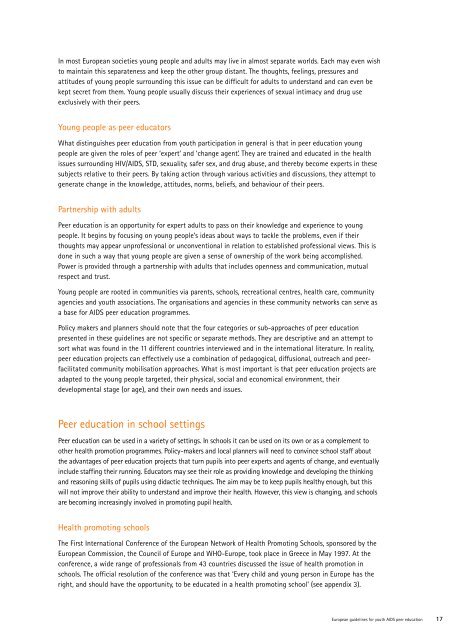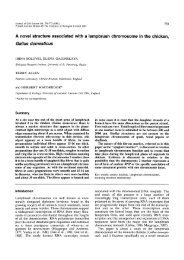European guidelines for youth AIDS peer education - University of ...
European guidelines for youth AIDS peer education - University of ...
European guidelines for youth AIDS peer education - University of ...
- No tags were found...
You also want an ePaper? Increase the reach of your titles
YUMPU automatically turns print PDFs into web optimized ePapers that Google loves.
In most <strong>European</strong> societies young people and adults may live in almost separate worlds. Each may even wishto maintain this separateness and keep the other group distant. The thoughts, feelings, pressures andattitudes <strong>of</strong> young people surrounding this issue can be difficult <strong>for</strong> adults to understand and can even bekept secret from them. Young people usually discuss their experiences <strong>of</strong> sexual intimacy and drug useexclusively with their <strong>peer</strong>s.Young people as <strong>peer</strong> educatorsWhat distinguishes <strong>peer</strong> <strong>education</strong> from <strong>youth</strong> participation in general is that in <strong>peer</strong> <strong>education</strong> youngpeople are given the roles <strong>of</strong> <strong>peer</strong> ‘expert’ and ‘change agent’. They are trained and educated in the healthissues surrounding HIV/<strong>AIDS</strong>, STD, sexuality, safer sex, and drug abuse, and thereby become experts in thesesubjects relative to their <strong>peer</strong>s. By taking action through various activities and discussions, they attempt togenerate change in the knowledge, attitudes, norms, beliefs, and behaviour <strong>of</strong> their <strong>peer</strong>s.Partnership with adultsPeer <strong>education</strong> is an opportunity <strong>for</strong> expert adults to pass on their knowledge and experience to youngpeople. It begins by focusing on young people’s ideas about ways to tackle the problems, even if theirthoughts may appear unpr<strong>of</strong>essional or unconventional in relation to established pr<strong>of</strong>essional views. This isdone in such a way that young people are given a sense <strong>of</strong> ownership <strong>of</strong> the work being accomplished.Power is provided through a partnership with adults that includes openness and communication, mutualrespect and trust.Young people are rooted in communities via parents, schools, recreational centres, health care, communityagencies and <strong>youth</strong> associations. The organisations and agencies in these community networks can serve asa base <strong>for</strong> <strong>AIDS</strong> <strong>peer</strong> <strong>education</strong> programmes.Policy makers and planners should note that the four categories or sub-approaches <strong>of</strong> <strong>peer</strong> <strong>education</strong>presented in these <strong>guidelines</strong> are not specific or separate methods. They are descriptive and an attempt tosort what was found in the 11 different countries interviewed and in the international literature. In reality,<strong>peer</strong> <strong>education</strong> projects can effectively use a combination <strong>of</strong> pedagogical, diffusional, outreach and <strong>peer</strong>facilitatedcommunity mobilisation approaches. What is most important is that <strong>peer</strong> <strong>education</strong> projects areadapted to the young people targeted, their physical, social and economical environment, theirdevelopmental stage (or age), and their own needs and issues.Peer <strong>education</strong> in school settingsPeer <strong>education</strong> can be used in a variety <strong>of</strong> settings. In schools it can be used on its own or as a complement toother health promotion programmes. Policy-makers and local planners will need to convince school staff aboutthe advantages <strong>of</strong> <strong>peer</strong> <strong>education</strong> projects that turn pupils into <strong>peer</strong> experts and agents <strong>of</strong> change, and eventuallyinclude staffing their running. Educators may see their role as providing knowledge and developing the thinkingand reasoning skills <strong>of</strong> pupils using didactic techniques. The aim may be to keep pupils healthy enough, but thiswill not improve their ability to understand and improve their health. However, this view is changing, and schoolsare becoming increasingly involved in promoting pupil health.Health promoting schoolsThe First International Conference <strong>of</strong> the <strong>European</strong> Network <strong>of</strong> Health Promoting Schools, sponsored by the<strong>European</strong> Commission, the Council <strong>of</strong> Europe and WHO-Europe, took place in Greece in May 1997. At theconference, a wide range <strong>of</strong> pr<strong>of</strong>essionals from 43 countries discussed the issue <strong>of</strong> health promotion inschools. The <strong>of</strong>ficial resolution <strong>of</strong> the conference was that ‘Every child and young person in Europe has theright, and should have the opportunity, to be educated in a health promoting school’ (see appendix 3).<strong>European</strong> <strong>guidelines</strong> <strong>for</strong> <strong>youth</strong> <strong>AIDS</strong> <strong>peer</strong> <strong>education</strong> 17
















